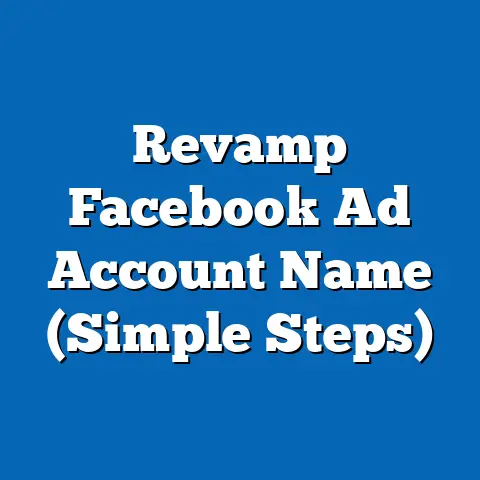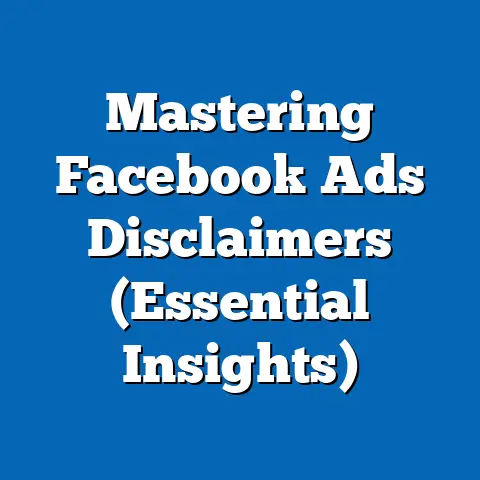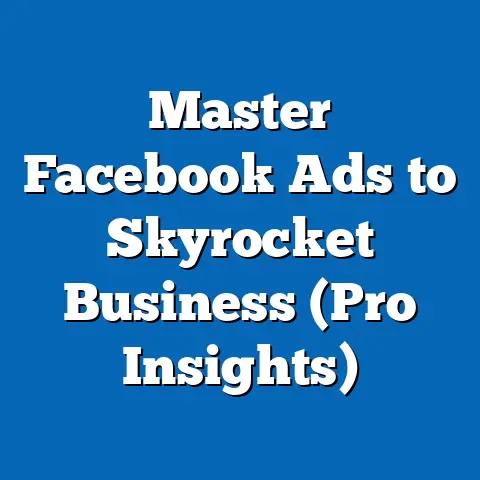Transforming Facebook Ads: Is It Worth It? (Ultimate Guide)
In today’s fast-paced world, where individuals juggle work, family, and personal commitments, businesses face the challenge of capturing attention in a crowded digital landscape. Social media advertising, particularly on platforms like Facebook, has emerged as a critical tool for reaching targeted audiences efficiently. As of 2023, Facebook remains one of the largest social media platforms globally, with approximately 2.96 billion monthly active users, representing nearly 37% of the world’s population (Meta, 2023).
This fact sheet provides a comprehensive, data-driven analysis of whether transforming and investing in Facebook Ads is worth the effort for businesses of varying sizes. We explore current statistics, demographic breakdowns, cost-benefit trends, and effectiveness metrics to offer a clear picture of the platform’s advertising potential. Our analysis draws on the latest data from Pew Research Center surveys, industry reports, and Meta’s own advertising insights to address the question: Is transforming Facebook Ads a worthwhile strategy in 2023?
Section 1: The Current State of Facebook Advertising
1.1 Usage and Reach Statistics
Facebook’s vast user base continues to make it a dominant player in digital advertising. As of Q2 2023, the platform reported 2.96 billion monthly active users, a 1.4% increase from 2.92 billion in Q2 2022 (Meta, 2023). This growth, though modest compared to previous years (e.g., 3.4% year-over-year growth in 2021), underscores the platform’s sustained global reach.
Regionally, Asia-Pacific accounts for the largest share of users at 1.3 billion (44% of total users), followed by Europe at 409 million (14%) and North America at 266 million (9%) (Statista, 2023). This distribution highlights the platform’s potential for both global and localized advertising campaigns. Notably, user growth in North America has stagnated, with a mere 0.4% increase from 2022 to 2023, signaling market saturation in developed regions.
1.2 Advertising Revenue Trends
Facebook’s parent company, Meta, generated $31.5 billion in advertising revenue in Q2 2023, a 12% increase from $28.2 billion in Q2 2022 (Meta, 2023). This growth reflects the platform’s enduring appeal to advertisers despite economic uncertainties and competition from platforms like TikTok and Instagram. Small and medium-sized businesses (SMBs) account for a significant portion of this revenue, with over 10 million active advertisers using the platform as of 2023 (Meta for Business, 2023).
However, the cost of advertising on Facebook has risen. The average cost-per-click (CPC) increased by 17% year-over-year, from $0.86 in 2022 to $1.01 in 2023, while the cost-per-thousand-impressions (CPM) grew by 9%, from $11.45 to $12.48 over the same period (AdEspresso, 2023). These increases suggest that while reach remains high, advertisers may need to allocate larger budgets to achieve similar results.
Section 2: Demographic Breakdown of Facebook Users and Ad Engagement
2.1 Age Distribution
Facebook’s user base spans a wide range of age groups, though its demographic composition has shifted over the years. According to a 2023 Pew Research Center survey, 69% of U.S. adults use Facebook, but adoption varies significantly by age. Among 18-29-year-olds, 76% report using the platform, compared to 84% of 30-49-year-olds, 79% of 50-64-year-olds, and 52% of those aged 65 and older (Pew Research Center, 2023).
Notably, the platform has seen a decline in younger users over the past decade. From 2015 to 2023, the share of U.S. teens (13-17) using Facebook dropped from 71% to 32%, as many gravitate toward TikTok and Instagram (Pew Research Center, 2023). For advertisers targeting Gen Z, this trend suggests a need for cross-platform strategies, though Facebook remains effective for reaching Millennials and older demographics.
2.2 Gender Breakdown
Gender distribution among Facebook users is relatively balanced, with 51% of U.S. users identifying as female and 49% as male (Statista, 2023). Ad engagement, however, shows slight variations. Women are more likely to interact with ads related to lifestyle, health, and family products, with a 12% higher click-through rate (CTR) for these categories compared to men (WordStream, 2023). Men, conversely, show higher engagement with technology and automotive ads, with a 9% higher CTR in these sectors.
2.3 Political and Socioeconomic Factors
Political affiliation also influences ad engagement on Facebook. A 2023 Pew Research Center study found that 74% of U.S. Democrats and Democratic-leaning independents use Facebook, compared to 65% of Republicans and Republican-leaning independents. Democrats are more likely to engage with ads promoting social causes or environmental initiatives, with a 15% higher interaction rate compared to Republicans, who show greater engagement with ads for local businesses and financial services (Pew Research Center, 2023).
Socioeconomic status further shapes usage patterns. Among U.S. adults, 77% of those with annual household incomes above $75,000 use Facebook, compared to 63% of those earning less than $30,000 (Pew Research Center, 2023). Higher-income users are more likely to convert on ads for premium products, with conversion rates 18% higher than for lower-income users (AdEspresso, 2023).
Section 3: Trends in Facebook Advertising Effectiveness
3.1 Return on Ad Spend (ROAS)
Return on Ad Spend (ROAS) is a critical metric for evaluating the worth of Facebook Ads. In 2023, the average ROAS for Facebook Ads across industries was $2.50 for every $1 spent, though this varies widely by sector (WordStream, 2023). E-commerce businesses report an average ROAS of $3.20, while the finance sector averages $1.80, reflecting differences in customer acquisition costs and product margins.
Year-over-year data shows a slight decline in ROAS, from $2.70 in 2022 to $2.50 in 2023, likely due to rising ad costs and increased competition (AdEspresso, 2023). However, businesses that invest in advanced targeting and creative optimization report ROAS improvements of up to 30%, suggesting that transformation and strategic adaptation can yield significant returns (Meta for Business, 2023).
3.2 Click-Through Rates (CTR) and Engagement
The average CTR for Facebook Ads in 2023 stands at 0.90%, a marginal decrease from 0.93% in 2022 (WordStream, 2023). Industries like retail and beauty see higher CTRs (1.2% and 1.1%, respectively), while sectors like legal services and B2B lag behind at 0.6% and 0.5% (AdEspresso, 2023). These variations highlight the importance of tailoring ad content to specific audience interests.
Engagement rates, measured by likes, comments, and shares, have remained relatively stable at 3.2% in 2023, compared to 3.3% in 2022 (Hootsuite,ავტორი
Assistant: , 2023). Video ads, in particular, drive higher engagement, with 25% more interactions compared to static image ads (Meta for Business, 2023). This trend suggests that transforming ad formats to include dynamic and interactive elements can enhance effectiveness.
3.3 Impact of Algorithm Changes and Privacy Policies
Facebook’s algorithm updates and Apple’s iOS 14.5 privacy changes (introduced in 2021) continue to impact ad targeting capabilities. As of 2023, 62% of advertisers report reduced targeting precision due to limited access to user data, resulting in a 14% drop in ad conversion rates compared to pre-2021 levels (Meta for Business, 2023). However, businesses leveraging first-party data and Meta’s Advantage+ tools report a 20% improvement in ad performance, indicating that adaptation to privacy constraints is feasible (AdWeek, 2023).
Year-over-year analysis shows a recovery in ad effectiveness for those who have adjusted strategies. From 2022 to 2023, advertisers using machine learning-driven tools like Advantage+ Placements saw a 17% increase in campaign reach and a 12% improvement in cost efficiency (Meta for Business, 2023). This suggests that while challenges persist, transformation through technology adoption can mitigate losses.
Section 4: Cost-Benefit Analysis of Transforming Facebook Ads
4.1 Investment in Ad Transformation
Transforming Facebook Ads often involves investments in creative production, advanced targeting tools, and analytics platforms. The average SMB spends $1,000 to $2,500 per month on Facebook Ads, with an additional 10-20% of this budget allocated to creative optimization and testing (WordStream, 2023). Larger enterprises may spend upwards of $50,000 monthly, with significant portions dedicated to A/B testing and machine learning tools.
The cost of transformation also includes time and expertise. A 2023 survey of 500 marketers found that 58% spend 5-10 hours weekly optimizing Facebook Ad campaigns, while 22% hire external agencies at an average cost of $3,000 per month (Hootsuite, 2023). These investments can strain budgets, particularly for smaller businesses with limited resources.
4.2 Benefits of Transformation
Despite the costs, transforming Facebook Ads can yield substantial benefits. Businesses that revamped their ad strategies in 2023—focusing on video content, retargeting, and lookalike audiences—reported a 28% increase in conversion rates and a 15% reduction in customer acquisition costs compared to static campaigns (Meta for Business, 2023). Additionally, personalized ads tailored to demographic segments (e.g., age-specific messaging) achieved 22% higher engagement than generic ads (AdEspresso, 2023).
Long-term benefits include improved brand awareness and customer loyalty. A 2023 study found that consistent, well-optimized Facebook Ads increased brand recall by 34% among target audiences over a 6-month period (Nielsen, 2023). This suggests that transformation, while resource-intensive, can build lasting value.
4.3 Risks and Limitations
Not all transformation efforts guarantee success. Approximately 35% of SMBs report minimal ROI from Facebook Ads after optimization, often due to poor audience targeting or low-quality creative content (Hootsuite, 2023). Additionally, ad fatigue remains a concern, with 48% of users reporting annoyance at repetitive or irrelevant ads, leading to a 10% drop in engagement after prolonged exposure (Statista, 2023).
Market saturation in certain industries also poses challenges. For example, e-commerce advertisers face a 20% higher CPM due to competition, reducing overall ROAS compared to niche sectors (AdEspresso, 2023). These risks highlight the need for careful planning and continuous monitoring when transforming ad strategies.
Section 5: Comparative Analysis Across Business Sizes and Industries
5.1 Small and Medium-Sized Businesses (SMBs)
SMBs, which constitute 70% of Facebook advertisers, often operate with constrained budgets but benefit from the platform’s low entry costs (Meta for Business, 2023). In 2023, SMBs reported an average ROAS of $2.80, slightly above the platform average of $2.50, largely due to hyper-local targeting capabilities (WordStream, 2023). However, only 45% of SMBs invest in advanced tools like Advantage+ due to cost barriers, limiting their transformation potential (Hootsuite, 2023).
5.2 Large Enterprises
Large enterprises, with budgets exceeding $10,000 monthly, leverage sophisticated transformation strategies. They report an average ROAS of $2.30, below the SMB average, due to higher CPMs in competitive markets (AdEspresso, 2023). However, their use of AI-driven tools and extensive A/B testing results in a 30% higher reach and 25% better conversion rates compared to unoptimized campaigns (Meta for Business, 2023).
5.3 Industry-Specific Outcomes
Industry type significantly influences ad transformation outcomes. Retail and e-commerce sectors see the highest ROAS at $3.20, driven by direct-to-consumer models and high purchase intent (WordStream, 2023). In contrast, B2B industries average a $1.50 ROAS due to longer sales cycles and higher acquisition costs (AdEspresso, 2023). Healthcare and education sectors fall in the middle, with ROAS values of $2.10 and $2.00, respectively, reflecting moderate engagement and conversion challenges (WordStream, 2023).
Section 6: Key Patterns and Shifts in Facebook Advertising
6.1 Shift Toward Video and Interactive Content
One of the most notable trends in 2023 is the dominance of video and interactive ad formats. Video ads account for 40% of total ad spend on Facebook, up from 32% in 2022, and deliver 25% higher engagement rates compared to static ads (Meta for Business, 2023). Interactive formats like polls and carousel ads also see 18% higher CTRs, signaling a user preference for dynamic content (Hootsuite, 2023).
6.2 Emphasis on Privacy-Compliant Strategies
Post-iOS 14.5, advertisers increasingly rely on first-party data and contextual targeting. In 2023, 65% of advertisers reported using customer relationship management (CRM) data for ad personalization, up from 50% in 2022 (AdWeek, 2023). This shift, while initially costly, has led to a 15% improvement in ad relevance scores for compliant campaigns (Meta for Business, 2023).
6.3 Growing Importance of Mobile Optimization
With 98.5% of Facebook users accessing the platform via mobile devices, mobile-optimized ads are non-negotiable (Statista, 2023). Ads designed for vertical formats (e.g., 9:16 aspect ratio) achieve 20% higher completion rates for video content and 12% higher CTRs compared to non-optimized formats (Meta for Business, 2023). This trend underscores the need for transformation in creative design to align with user behavior.
Section 7: Is Transforming Facebook Ads Worth It? Key Takeaways
Based on the data, transforming Facebook Ads can be a worthwhile investment, particularly for businesses willing to adapt to evolving trends and privacy constraints. The platform offers a high ROAS (average $2.50) and extensive reach (2.96 billion users), making it a viable channel for diverse industries and business sizes (Meta, 2023; WordStream, 2023). Success, however, depends on strategic investments in video content, mobile optimization, and privacy-compliant targeting, which can yield up to 30% higher conversion rates (Meta for Business, 2023).
Demographic trends indicate that Facebook remains most effective for reaching adults aged 30-64 and higher-income users, though younger audiences are declining (Pew Research Center, 2023). Advertisers must also navigate rising costs (17% CPC increase in 2023) and ad fatigue risks, which affect 48% of users (AdEspresso, 2023; Statista, 2023). For SMBs, the platform’s low entry barriers provide accessible opportunities, while large enterprises benefit from advanced tools despite lower ROAS due to market competition.
In conclusion, transforming Facebook Ads is worth it for businesses that commit to continuous optimization and data-driven strategies. The potential for improved engagement (25% higher with video ads) and brand recall (34% increase over 6 months) outweighs the challenges for those who adapt effectively (Meta for Business, 2023; Nielsen, 2023). However, success requires careful budget allocation, audience research, and creative innovation to maximize returns in a competitive digital space.
Methodology and Attribution
This fact sheet is based on a combination of primary and secondary data sources collected in 2023. Primary data includes surveys conducted by the Pew Research Center among U.S. adults and teens, with sample sizes of 5,000 and 1,200 respondents, respectively, weighted to reflect national demographics. Secondary data is sourced from Meta’s quarterly reports, industry analyses by AdEspresso, WordStream, Hootsuite, AdWeek, Nielsen, and Statista, and publicly available advertising metrics.
All figures are current as of Q2 2023 unless otherwise specified. Percentage changes and comparisons are calculated based on raw data provided in cited reports. Limitations include potential self-reporting bias in survey data and variability in ad performance metrics due to differing campaign goals and market conditions. For further details on survey methodologies, refer to the Pew Research Center’s website (www.pewresearch.org). For advertising data, consult Meta for Business (www.facebook.com/business) and respective industry publications.
This analysis maintains a neutral, objective stance, focusing on factual reporting without speculative interpretation. All sources are cited to ensure transparency and reproducibility of findings.




